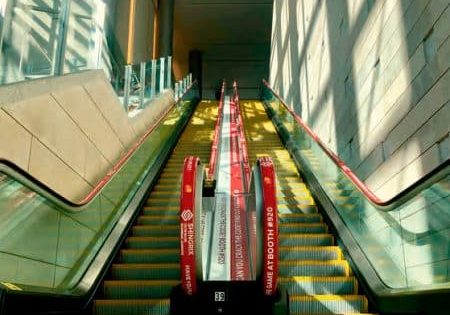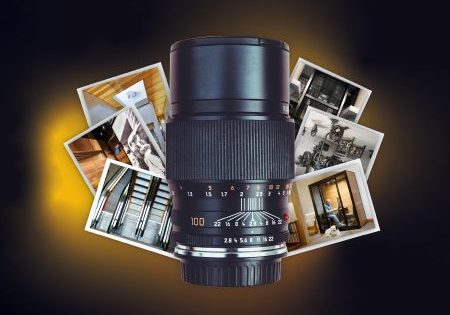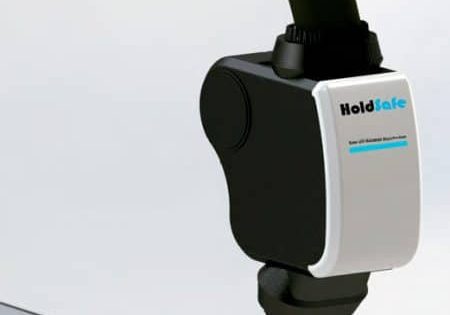Elevators and Social Distancing
Jul 1, 2020
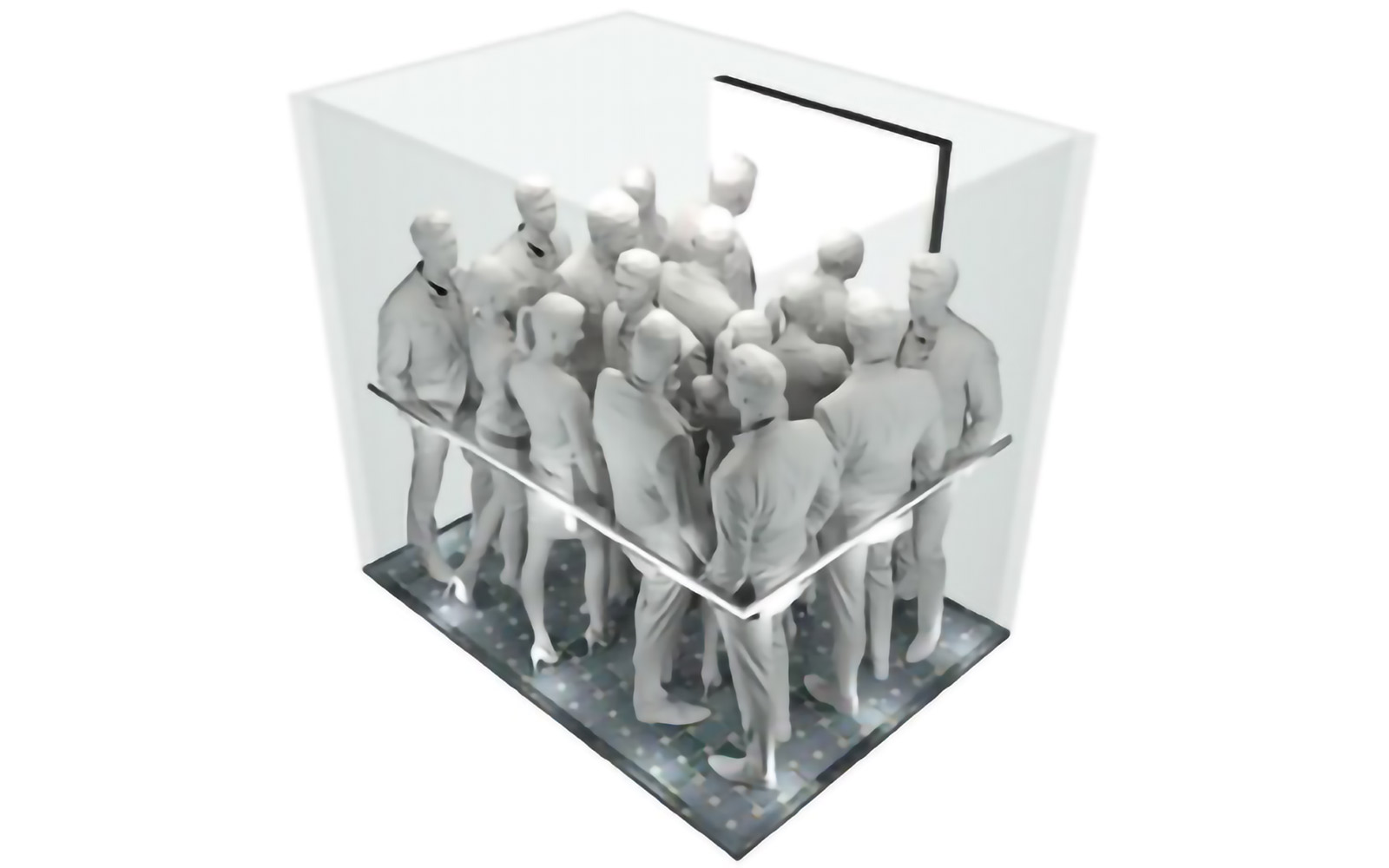
Measures to control traffic flow during the pandemic
submitted by Elevating Studio Pte. Ltd.
This guideline explains the technical aspects of and considerations for using elevators during the COVID-19 pandemic. We provide options that allow social distancing in elevators and examine the impacts these measures have on building usage, traffic and average wait time (AWT). The guideline focuses primarily on office elevators, but many of the measures and recommendations can be applied to elevators in other types of buildings.
Keeping a safe social distance during the pandemic is one of the fundamental measures to curb the spread of the virus. Depending on country, the recommended social distance is 1-2 m. However, maintaining social distance in an elevator is not easy. Taking an elevator is very common for most people. Most of us are accustomed to standing much closer to each other in an elevator than we would in a larger space. Lastly, the psychology of lockdown — and the psychology of social-distancing measures post-lockdown — suggests that sticking to the rules gets harder the longer the crisis persists. Hence, if we want to ensure social-distancing practices are applied in elevators sustainably, we must apply special measures.
Elevator Cabin Usage and Fill Rate
Consider a commonly used ISO 4190-12-compliant office elevator with a 1600-kg/21-person capacity and dimensions of 2,100 mm wide X 1600 mm deep. During the typical morning up-peak and lunch peak in a well-designed elevator system, the car will be filled to approximately 65% of its rated load. This means that, during these peaks, 13-14 people are inside the space. This is a considerably higher density than that allowed for safe social distancing. Figure 1 shows a 2000-kg/26-person capacity car with 16 persons inside (16/26 = 62% of the rated load). It is clear that not many more people will enter this elevator and that social distancing is simply not possible.
Complying With Social Distancing in an Elevator Car
To comply with social distancing, very low occupancy levels (three to five persons) in a 21-person elevator are necessary. The shape of the car will impact how many people can safely be allowed in the car to allow social distancing. Applying social distancing in a21-passenger elevator car would be like changing the elevator capacity to that of a much smaller “telephone booth” cabin used in some European countries. Applying warning stickers on the elevator car floor to indicate where passengers should stand and which direction they should face may be recommended.
This is very useful in both elevators with conventional control and destination control systems (DCSes), and passengers are more likely to follow behavioral rules, which is illustrated in Figures 2 and 3.
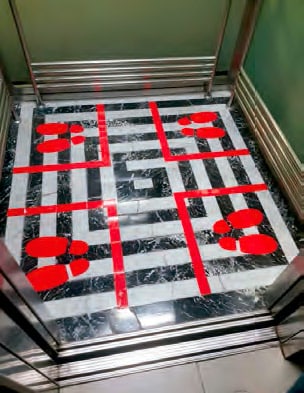
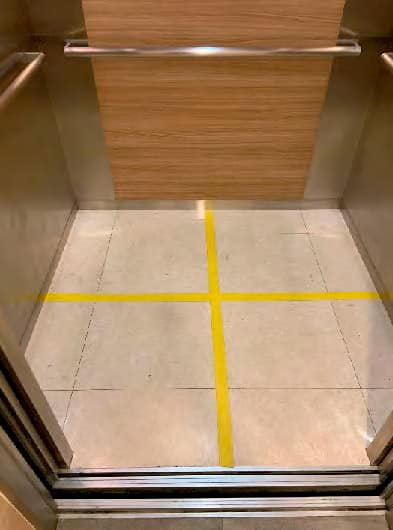
Reducing the maximum number of passengers in the cabin will significantly reduce the handling capacity of the elevators in a 5-min period during the peak. Reduced handling capacity will lead to major problems in fully populated buildings.
Passengers will no longer fit into the elevators, and queuing in the elevator lobby will increase. AWT also increases exponentially. Queuing in the lobby also means social distancing in the lobby will be exceeded. As part of the lockdown measures being imposed in many countries globally, office populations have reduced dramatically. For elevators to function correctly with in-car social distancing, the population of the building should be reduced below the amount found by the following formula:

(1)
where PBP = pandemic building population (maximum building population in persons during the pandemic; NBP = normal building population (population, in persons, before the pandemic); N = number of persons allowed in car for social distancing (e.g., five); and CL = car rated load (persons).
If Building Population During the Pandemic Exceeds PBP
If the building population during the pandemic exceeds PBP, the elevators will not be able to cope with the traffic. This will be the case in the early stage of the pandemic when no or limited precautionary measures or quarantine requirements have been applied by the government, or when orders to work from home are being lifted. Under such conditions, elevator capacity should not be reduced, as this will cause excessive queuing in the lobby. This, in turn, will have a negative effect on social distancing in elevator lobbies. The best way to protect elevator users is to minimize the spread of the virus by using other commonly applied preventive measures, described below. Most countries have issued specific measures or health guidelines to minimize the spread of infectious diseases. These must always be followed.
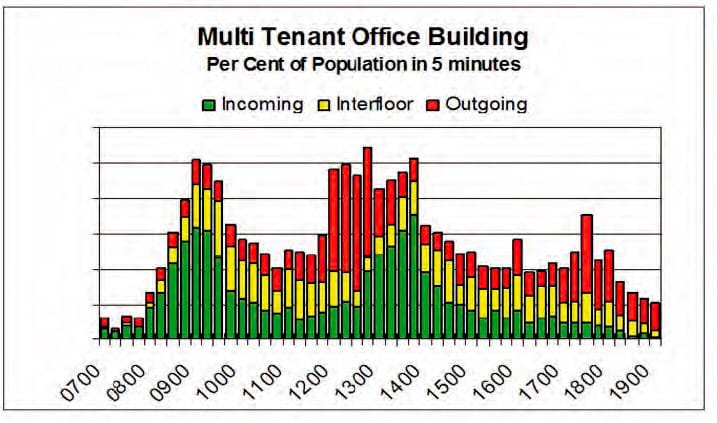
Figure 4[3] shows building traffic over the day in a multitenant office building. The maximum vertical peaks represent approximately 12% of the population arriving in a 5-min period, i.e., the arrival rate. During these peaks, elevator cabins are typically full, with an approximately 65% fill rate. This means social distancing cannot be achieved. If social distancing is enforced during the peaks, the elevator system will saturate very quickly; more people will arrive in the lobby than the elevators are able to dispatch. Queuing will increase exponentially. AWT can be as high as 30-60 min or more, both in the main lobby and on all other floors. This is a very dangerous situation in case of a building evacuation; medical emergency; and potential anger, aggression and rage from users.
In office buildings, one solution to reduce traffic peaks is to stagger all tenant arrivals into three peaks. This means different tenants/floors will arrive in the building during different timeslots, which will lower the peaks. This must be applied during the morning, lunch and evening peaks.
Staggered arrival of the building users/tenants (in blocks during the peaks) will lessen the peaks. Even then, one must also prevent off-peak traffic so it remains low enough to allow social distancing. This methodology will work only if the building population can be kept below 50-60% of normal.
A more exact maximum level of occupation may be analyzed for each building based on population density, passenger arrival rate and elevator system capacity. The accuracy of such analyses is subject to the data available in the elevator monitoring system and/or turnstiles.
If Building Population During the Pandemic Is Below PBP
If the building population during the pandemic is below PBP, the elevators will be able to cope with the traffic and automatically adapt to the lower traffic flow (lower arrival rate). Lower traffic flow will also reduce the average number of people using each car. Typically, the number of passengers inside the elevator car will be at or below the desired number, per social-distancing measures. Several technical measures can be considered to guarantee that no more than five people use the elevator at the same time.
Reduced handling capacity will lead to major problems in fully populated buildings.
Technical Measures to Ensure Social Distancing
Elevators With Conventional Control
To ensure social-distancing measures are enforced, the following technical measures may be considered for conventional control elevators. Two main settings are relevant:
- Overload: A function to keep car doors open when the car is overloaded. A warning voice and/or an alarm signal (buzzer) is activated. In some cases, a warning light or signal will flash on the car operating panel (COP).
- Bypass: A function that has the elevator automatically bypass hall calls when the car is loaded to a preset limit. When the bypass load is reached, the elevator will not stop during the journey to pick up more passengers.
Measuring the load inside the car is done by a sensor called a load weighing device (LWD). An LWD is required by code and used in every elevator globally. The setting of the overload and bypass loads is typically done onsite. The elevator contractor can be asked to adjust controller settings to the appropriate level(s).
The maximum population inside the elevator according to social-distancing rules can be achieved by readjusting the overload setting to one person more than allowed by social distancing. In case social distancing allows a maximum of five persons, the overload is set for 450 kg or six persons (6 x 75 kg = 450 kg). The bypass function should be set to the load per social-distancing rules, which is 375 kg or five persons (5 x 75 kg = 375 kg).
The overload and bypass settings must be readjusted using test loads, which is typically very easy. However, depending on the type of LWD used, some elevators may require the LWD to be changed to another type to cope with the clearly lower load functions. Consult your elevator contractor about this.
The newly adjusted overload setting will cause the overload buzzer to activate when the sixth person enters the car, exceeding the maximum allowed number of five passengers. The buzzer indicates to users that the last person entering must leave before the elevator will depart. The newly adjusted bypass setting will prevent the car from stopping unnecessarily for landing calls when the maximum number of passengers allowed in has been reached.
In some countries or regions, the bypass and overload settings should be adjusted for the local situation. For instance, in some countries in Asia, Africa and South America, the use of a weight of 65 kg or 68 kg per person is appropriate. In Australia, Europe, China and Russia, 75 kg is typically acceptable; in the U.S., a weight of 85 kg or 90 kg may be more in line with the reality.
When government social-distancing restrictions are relaxed, and/or when a vaccine is found, the LWD settings must be readjusted back to the original values to ensure the elevator system can handle the increased traffic. Adjusting the LWD settings may not be covered by the elevator maintenance contract, and the elevator contractor may charge for the work.
Elevators With DCS To minimize the number of stops elevators will make on a journey, elevators with a DCS will assign passengers with the same destination to the same cars. In this way, DCS significantly increases elevator system efficiency. When there are low arrival rates (such as very early in the morning), some of the smarter and more intelligent DCSes will understand that extra capacity is not needed and thus assign the first arriving car and let the elevator depart. During this situation, the number of passengers per car will be very low. When the arrival rate increases during the morning up-peak and lunch peak, the control system will optimize elevator usage and assign more passengers to each car — usually up to 65% of the nominal load. In this situation, the number of passengers allowed for social distancing will be exceeded.
The best way to prevent the DCS from exceeding the number of passengers allowed under social-distancing rules is to artificially reduce the size of the elevator car in the control system. Thus, the programming in the software for the earlier example of a 1600 kg/21-person elevator will need to change to a 600 kg/eight-person elevator (approximately 350 kg at 65% car fill rate). In some elevator manufacturers’ DCSes, it is possible to change the programmed car size by changing some software parameters. In others, this can only be done by hardcoding the DCS software. The most appropriate method and exact value of readjustment depends on the capabilities of the elevator manufacturer’s software, settings and algorithms.
The best way to prevent the DCS from exceeding the number of passengers allowed under social-distancing rules is to artificially reduce the size of the elevator car in the control system.
In addition to changes in DCS software, overload and bypass functions must be readjusted in the same way as conventional-control elevators. This is to prevent passengers from following their colleagues working on the same floor (tailgating). It is recommended that stickers with instruction on the usage of the floor area on the floor inside the elevator be installed. If the car size is not parametrized in the software, these software changes may take time to execute, and a copy of the old DCS software must be retained.
Other Methods to Minimize the Spread of COVID-19
Several measures and methods can minimize the spread of bacteria and viruses, including the coronavirus that causes COVID-19. The most common are:
- Clear instructions on how to behave or not behave in elevators and escalators
- Use of masks; gloves; and, possibly, glasses
- Using a pen or other object to operate elevator buttons (sharp objects should not be used.)
- Frequent cleaning of all touched surfaces with disinfectants (especially handrails, landing call buttons/panels, COPs and buttons, car door, mirrors, etc.) at certain intervals per day, hour or elevator ride
Special technologies or applications found in the market include:
- Air-filtering/-sterilization ventilation units with or without a high-efficiency particulate air filter. Such units can be installed inside or on top of the elevator cabin. Some of these units use ultraviolet (UV) light to sterilize the air.
- UV light in the cabin to sterilize surfaces
- Application of special self-sterilizing or inherent antimicrobial materials (copper, etc.) for buttons, wall surfaces, handrails and elevator doors
- Self-sterilizing or antimicrobial coatings on various surfaces (spray or lacquer)
- No-touch hologram buttons
The methods or special technologies should be considered in consultation with the elevator contractor. Some measures or cleaning materials may adversely affect the lifetime of some elevator components or parts (especially aggressive cleaning detergent or disinfectants, or paint or spray).
This guide is a general advisory on the use of elevators during the pandemic, with examples of global best practices to minimize risk of infection. In many countries, local government organizations or public health organizations have issued specific instructions, measures or health guidelines to minimize the spread of COVID-19. Any public guideline or local/national government recommendations must always take precedence over this guideline, where applicable. Elevating Studio is not liable for any direct or indirect damages, in any shape or form, resulting from the use of the information provided, in any country or court of law. It is recommended that one discusses and consults with his or her local elevator consultant and/or elevator contractor, and local health experts, to discuss the best course of action.
References
1] smilesarasota.com/category/about-smile-sarasota
2] ISO 4190, 2010 (E), Elevator Installation, Part 1, Fourth Edition, May 15, 2010.
3] The Chartered Institution of Building Services Engineers (CIBSE). CIBSE Guide D: 2015, p. 4.5, Siikonen.
4] hitachi.com/businesses/elevator/covid-19/?guideline
Get more of Elevator World. Sign up for our free e-newsletter.

